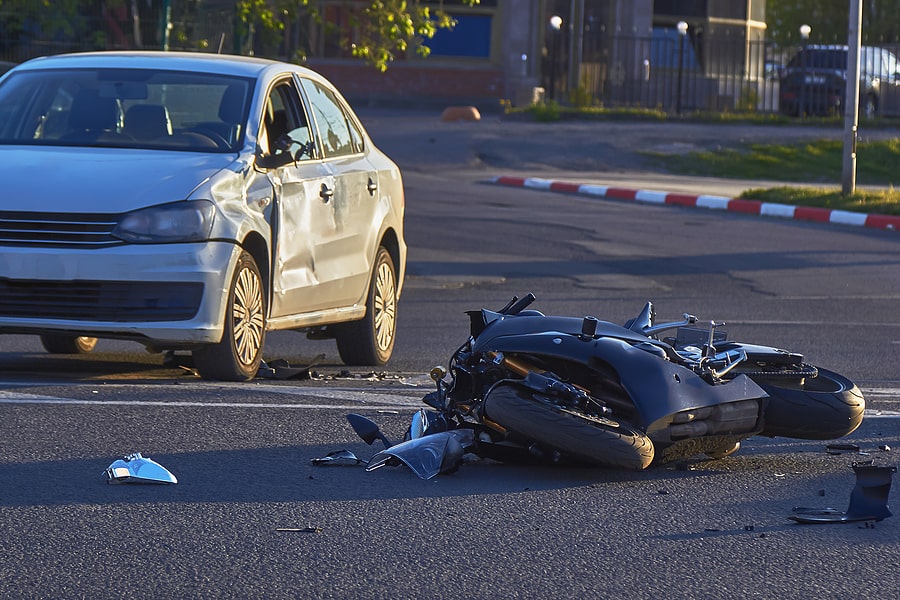
While roughly 20 percent of passenger vehicle accidents cause injuries or fatalities, a shocking 80 percent of motorcycle crashes result in injuries or fatalities. Whether your accident resulted in injuries or not, there are several crucial things you need to check after a motorcycle accident. Making these checks can help decrease your accident-related expenses and damages and help you mitigate any potential financial, legal, and medical problems.
A motorcycle accident can leave you perplexed and unsure about what you need to do in the days and weeks preceding your accident. If you are having trouble getting your bearings and knowing what actions to take, here is what you need to check after a motorcycle crash.
Your Injuries
Above all else, get yourself medically checked. If the emergency personnel doesn’t take you to the hospital by ambulance from the scene of the accident or you don’t take yourself, you should see your doctor as soon as possible. Many motorcyclists have no identifiable injuries after an accident, and initially, they feel fine, thanks to a rush of adrenaline. However, once the adrenaline wears off and a few days go by, they might start to notice pain and other signs of injury.
Getting checked by a doctor isn’t just in the best interest of your health, but it is also for your insurance claim. If you don’t get checked within a reasonable amount of time after the accident, the insurance company could argue that whatever injuries you have are not the result of this motorcycle accident, but rather the result of something else that happened to after the accident. The sooner there is medical documentation of your injuries, the less of an opportunity the insurance company will have to make this argument.
If anyone was on the motorcycle with you when the accident happened, you should also make sure they get checked by a doctor and receive any medical treatment they require.
Check for Damage to Your Bike
If the accident did not entirely mangle your motorcycle and you think it can be repaired or even if you were in a minor accident, it’s a good idea to give it a good once over to assess the damage. Getting back on a bike that has sustained damage can be dangerous to you and others on the road.
When you are physically able, do the following to check your motorcycle for damages and safety:
- Put the motorcycle in neutral and roll it back and forth several times. If you notice crunchy sounds or feel resistance, there is damage to your bike.
- Inspect your tires for gashes in the tread or sidewall. Even if your tires appear to be holding air, you could have a slow leak or a dangerous tire blowout.
- Check the wheels for dents that keep the tires from seating as they should. Look to see if there is a cracked rim. Then spin the wheels to make sure they are tight on the hub.
- Check your brakes and rotors by assessing if the wheel spins freely without resistance. Remove any type of debris lodged in the brake and rotor. You should also check the brake lines and reservoirs for leaks and cracks. If you can squeeze the caliper, the line is intact. A damaged line will likely have additional pressure. If you can’t squeeze it, you have a leak or a loss of fluid. Make sure the rotors are not cracked or bent.
- Check the controls, such as your clutch and front brake lever and lines. Levers typically break first. Your foot controls can bend or snap off so that you aren’t allowed the range you require. Inspect the pegs and brackets to see if the accident broke any.
- Ensuring your electronics and lights work correctly is also essential, so start your motorcycle and check the headlights, blinkers, cutoff switch, horn, and brake lights. Those are some of the most critical things to check right now. Remember to check your front brake and rear foot pedal to engage the brake light.
- Look on your bike and the ground around your motorcycle. If you see any oil, brake fluid, or coolant on the outside of the bike, find out its source. Check the bike’s frame and subframe. If your seat appears to be coming off the tank at an odd angle, your motorcycle might require a new subframe.
- If all of these things check out okay, it’s time to give it a brief test drive. You are more familiar with your bike than anyone else, and you might notice that something just feels off or different. Use that to help determine if it is safe to drive.
When to Call for a Tow
Make no attempts at getting on your motorcycle unless you are sure it’s safe to do so.
If you notice any of the following, you will need to call a tow truck or someone with a pickup truck who can help transport your bike without riding it:
- A cracked rim
- Low or flat tires
- A broken brake line; unable to squeeze the caliper
- Broken primary controls, including the footpegs, pedals, levers, clip-on or bent bars
- Bent forks, leaking suspension
- Any obvious frame or motor damage
You should also note that you should not reuse your helmet once it has been in an accident. Even if it still looks intact and unscathed, it can have damage to the necessary Styrofoam inner liner meant to absorb the shock in a crash. Damage to this part is often visible to the naked eye. If you were in a crash, it’s time to get a new helmet.
Check on Getting the Accident Report
No matter how minor your accident seems immediately after it happens, it is crucial to call local law enforcement and ask them to create a report. A police accident report is an impartial third-party description of the motorcycle accident.
It typically includes:
- The date and time of the accident
- The location of the accident
- The extent of damages to the vehicles involved
- The injuries suffered by all involved parties
- The statements of witnesses to the accident
- The statements of all drivers involved
Your chances of a successful injury claim increase if you have the evidence and information contained in a police report. You or your lawyer can get the police report when it is ready directly from the law enforcement agency. It can take several days to a week before the officer has the report prepared. When you call the insurance company to report your claim, they will likely ask you for a copy of the police report. If you do not have it, they can contact the police department and request it.
Check on Insurance Coverage
You also need to check what kind of insurance coverage you have available and its policy limits. With this information, you can decide which insurance company you want to handle your claim and how you will get your motorcycle fixed or repaired.
Depending on whether you live in a no-fault state or not, you can either file a claim with the at-fault party’s insurance company or one with your own insurance company. If you file a claim with the other driver’s insurance carrier, this is known as a third-party claim. They are responsible for paying your economic and non-economic damages up to the liability policy limits.
If you file a claim with your own insurance company, it is a first-party claim. Your medical bills will fall under your medical payments or Med Pay, coverage, and your property damages under your collision coverage.
Keep in mind that collision coverage is optional. If you didn’t have this coverage on your policy before your motorcycle accident, you cannot use it now for your bike repairs. However, if you do have it, it is sometimes a faster way to get your bike repaired than going through the at-fault driver’s insurance company. If you take this route, your insurance company can attempt to recoup any deductible you pay to use your collision coverage using a process known as subrogation. If they are successful, they will refund your deductible.
Check Your State’s Statute of Limitations
Every state has its own statute of limitations. A statute of limitations is a law that limits how long motorcycle accident victims have to file a lawsuit after their injury. Once this deadline passes, they no longer have a valid claim. They can still file a lawsuit, but the chances are high that the defendant will request that the court refuse to hear the case.
Your best chance of having a successful motorcycle accident case is to find out what your state’s statute of limitations is. You can research the statute of limitations yourself or speak to a motorcycle accident lawyer who is familiar with your state’s laws. Many states have a statute of limitations between one and three years that begins on the day of the injury. If your claim is against a government entity, you generally have around a year.
In some situations, a court can toll (in other words, pause) the statute of limitations. For example, if your motorcycle accident left a minor passenger with injuries, they could likely toll the statute of limitations until their 18th birthday. The statute would then run from that date instead of the date of the accident.
Check in on Yourself
The days and weeks following your accident can be busy as you attempt to recover, deal with insurance companies, live your everyday life, and get your motorcycle fixed or replaced. It could all seem like a blur.
Check in on yourself during this time. How are you feeling? How has the accident and other injuries affected you other than physically? One way to do this is to keep a journal and write down how you feel physically and emotionally every day.
Taking this step will help you prove non-economic damages such as:
- Your mental and physical pain and suffering
- Loss of enjoyment of life
- Your scarring and disfigurement
- Loss of consortium
Since non-economic damages are very subjective, it can be challenging to prove their existence and how much they are worth. By being mindful of how you are doing and keeping a journal, you can help maximize your claim.
Check to See if You Have a Motorcycle Accident Claim
Check with an attorney to determine if you could have a claim. However, you can also look for several specific elements within your case that prove negligence.
If you did file a motorcycle accident claim, you or your attorney would have to demonstrate:
- Duty – The at-fault driver owed you a duty of care, such as checking their rearview mirror before switching lanes.
- Breach of duty – The other driver did not uphold their duty.
- Injuries – The driver’s actions are what caused your injuries.
- Damages – Your damages, such as medical bills, property damage, and emotional pain and suffering, are the direct result of your injuries.
Check With a Motorcycle Accident Attorney
Finally, you should always check with a motorcycle accident attorney. Many offer free consultations to determine if you have a motorcycle accident claim worth pursuing in the legal system. If you do, most work on contingency fees, and you will not have to pay anything until they settle your lawsuit or obtain a court award. During your consultation, the lawyer can also provide you with an estimate of what your case might be worth.
An attorney can help you gather evidence to support your compensation claims. They can negotiate a full and fair settlement with the insurance company. If not, they can pursue compensation on your behalf in court. If you do not have a consultation with an attorney after your motorcycle accident, you could be denying yourself the money you need and deserve.














